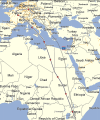
Flights to and from Nairobi
Private homepage – Hans-Georg Michna
Kenya travel reports: 1999, 2000, 2002, 2003, 2004, 2005, 2006, 2007, 2008, 2009, 2010, 2011, 2012, 2013-Goma, 2013, 2014, 2015, 2016, 2017, 2018, 2019
Kenya Safari Travel Plan, Kenya 1980-2000 photos
Kenya 2012
A personal travel report from Kenya in May and June 2012
Last change: 2012-06-14 – Copyright © 2012-2023 Hans-Georg Michna
Click on the small pictures to see them enlarged, usually to 800 x 600 pixels.
Times are given in local Kenyan time in 24 h format (without "am" or "pm"), i.e. 0:00 to 23:59.
All photos are subject to copyright ©. If you want to reuse any photo, send me an email asking for permission, and I may send you the full-size photo, usually 1,600 x 1,200 pixels. Photos bear the copyright © 2012-2023 Hans-Georg Michna.
EXIF times in the pictures are UTC; add 3 hours to get Kenya time.
[Still the same camera—my Panasonic Lumix DMC-FZ1-2 digital camera. Most photographs in this travel report are reduced to 800 x 600 pixels and JPEG-compressed with medium strength to make them more palatable for the web.]
My temporary phone number in Kenya no longer works. Please delete it, if you stored it.
| Departure | Arrival | Flight |
|---|---|---|
| 07:20 Sun 13 May, Munich | 09:00 Sun 13 May, Paris CDG | AF 1123 |
| 11:00 Sun 13 May, Paris CDG | 20:30 Sun 13 May, Nairobi | KQ 113 |
| 08:15 Sun 3 June, Nairobi | 15:55 Sun 3 June, Amsterdam Schiphol | KQ 116 |
| 17:50 Sun 3 June, Amsterdam Schiphol | 19:15 Sun 3 June, Munich | KL 1799 |
My travelling checklist in michna.com/kenya.htm#Preparations (German version michna.com/kenia.htm#Reisevorbereitungen) is, as always, my means of packing without fear of forgetting anything important. As usual, the packing and other preparations take at least a full day of concentrated work, because they cover an immense number of small things and details. Without the checklist I'd be lost.
KLM, Air France, and Kenya Airways on their flights To Nairobi currently allow two pieces of baggage of up to 23 kg each in the economy class. KLM also has a pretty good and informative web site, allowing ticket purchase, online check-in, and often seat selection.
My experience on such international flights, particularly from Nairobi, is that a lot of stress can be taken out of the check-in procedure by being at the airport just 10 to 15 minutes earlier than needed. In Munich the rush seems to begin 90 minutes before departure, in Nairobi at least two hours. Be there before that rush and everything is a lot more relaxed.
This time I had no safari group with me. Only my wife accompanied me.
The evening before everything was packed, checked against the check list, and ready to go. Unfortunately, as I discovered only when it was already too late, I forgot one little detail—the power adapter for my notebook. Of course, things like this are in the check list, but that does not help all too much when you believe you have already packed something. I'll have to think about that. Everything else was perfect though.
The flights were uneventful, but my memory of Paris "Charles de Gaulle" (CDG) is now tainted. We had to pass a security check in the middle of the airport. There was a huge crowd of people standing in line, and that took about one hour.
Apparently the airport is not well organised. Due to the two hours we had, we still got on our flight to Nairobi on time.
After boarding, the plane did not undock. It turned out that airport security pulled one passenger from the plane, then the workers had to unload the luggage again to identify and remove that passenger's luggage. Finally the plane was searched for his hand luggage. All this took another hour. Then we finally took off and had a nice, if somewhat late flight to Nairobi. The route led us past the wonderful Mont Blanc, along the Italian coast, aross the Mediteranean Sea, over Benghazi into Lybia, unusually not over Sudan's capital Khartoum, but well to the West of it, so we saw the river Nile only briefly, when crossing it later, and, after nightfall, into Kenya. We landed in Nairobi three quarters of an hour after the scheduled arrival time.
The aeroplane crew had distributed a customs and an immigration form, but no visa application. Foreseeing this, I had already printed those and had taken them with me, which accelerated our arrival significantly, as most people before us in line were sent back to grab and fill out this form.
The immigration counter room has been modified. Since the line was not too long, we did not even try to find out whether the alternative second immigration counter room still exists and is accessible.
All our luggage arrived complete and undamaged. Customs waved us through after a few questions, and off we went to the Aero Club of East Africa by taxi., where we had a good night's sleep.
It took us two days to work through our next check list, which included buying local SIM cards (Safaricom) for our phones, collecting the car, having its clutch adjusted for a little less play, finding a replacement power adapter for my notebook, sending SMS to several people, trying to reserve an aeroplane for our next visit to Kenya, visiting friends, etc.
Our car is, as usual, a Suzuki Maruti Gypsy. It is in good condition. Unlike the green and white ones we had driven in previous years, this one is entirely white.
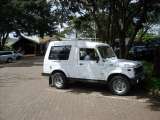
Our white Suzuki Maruti Gypsy in front of the Aero Club of East Africa
The rainy season has not ended yet. Nairobi has a mixture of sunshine, showers, and the occasional thunderstorm with temperatures reaching a maximum of around 25°C. I had to use an umbrella once to get to the car, and while we were in the Sarit shopping mall in Westlands, a brief, but intense rain shower came down. When we left the mall and walked across the parking lot to our car, we caught the last few drops of it.
I woke up early and watched an incredibly beautiful sunrise. After working a bit on the newly revived computer, we had breakfast and set off for Emali. Since the entrance fees of the KWS nature reserves had been hiked up to $80 per person for up to 24 h, we tried to economize by making the best of 24 h by spending the night outside the reserve and entering the next morning. This also saves one expensive night in a wildlife lodge without shaving much time off the actual experience. This also has the advantage that we don't have to leave very early in the morning and thus takes some stress out of the schedule.
We drove off in the late morning, left Nairobi along the Mombasa Road, and aimed for Emali, which is the last bigger town before Amboseli.
Emali is the city of onions. I have never seen so many onions before. The first thing that happens when you enter Emali is that a bunch of people with bundles of onions in their hands run towards your car and try to sell them to you. The little sales booths along the road are all full of onions, with only a few tomatos here and there.
In Emali we filled our tank, even though we had used only about 15 l, asked for the best hotels in town, and were given two recommendations.
The first one was good enough, but the rooms were dark and kind of smelly. We had committed ourselves to look at both hotels anyway, so we drove over to the other one and looked at the rooms there.
We found them more pleasant, with bigger windows and without smell, but with a bunch of mosquitos. We took the room anyway and added another smell, namely that of insect spray.
The better hotel was also cheaper, at KSh 1,750 for the double room, including breakfast.
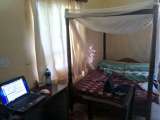
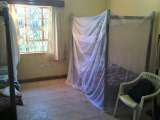
Our hotel room in the morning sun
We had a nice lunch in the attached restaurant, sitting outside under a roof, which was a good idea during a passing rain shower.
When I went back to the car to get our luggage, I looked at the tires and noticed that the front left tire had radial traces of oil all over the outer side. I called Sajid Rasul, and he recommended that we take the car to a nearby petrol station to let a mechanic find the cause.
So we did and were offered a permanent repair. Apparently a washer between the axle and the free wheeling lock had broken. It was replaced, everything was put together again, and the wheel was washed, so we would notice any further oil leaks. I wanted to do a test drive at high speed to tax the repair a little, but the mechanic decided to do the test drive himself. Instead of driving at high speed, he did a test drive around the town and found no more oil seeping out.
We used the rest of the afternoon to communicate, for example, to continue to write this travel report. Later, after a dinner in the restaurant, we went to bed and, unlike others, who count sheep, we counted the trucks that thundered over the nearby speed bump on the nearby Mombasa Road. Ear plugs once again proved to be helpful.
After breakfast we set out for Amboseli, but after driving a few kilometers at some higher speed, we heard a strange noise from the left front wheel. I found that the freewheeling lock had been put together in the wrong way and that again some oil was seeping out. The problem was apparently more difficult than the petrol station mechanic had thought.
We called Sajid Rasul, who sent his mechanic along with a replacement car of the same type. The mechanic arrived in the early afternoon, analyzed the situation, and decided to drive the broken car back to Nairobi to repair it in the workshop. So we loaded our luggage from the broken car into the new one and continued to Amboseli without any further incident.
Lessons learned:
We slept reasonably well. I woke up around 7 o'clock in bright daylight on this cloudy day. The weather forecast for this area promised no more rain and temperatures between 17°C in the morning and 31°C max. The altitude here is much lower than Nairobi, hence the higher temperatures.

The drives to and from Amboseli
After cups of tea and coffee we set out for an early-morning game drive along the main Amboseli swamp, which was very beautiful and successful. Kilimanjaro was mostly clear of clouds in the early morning, but gradually grew its typical cloud cap later. We even saw two male lions, though not in a suitable situation for photos.
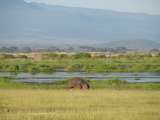
Grazing hippo in front of the swamp
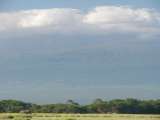
Elephants in front of the now almost entirely cloud-covered Kilimanjaro
We met a group of elephant bulls with a single elephant cow. This situation typically ensues after mating. We did not see the actual mating. Elephant cows are receptive only for a very short time and prefer to mate with the highest-ranking bull in the area. Since the bulls' ranks rise when they are in musth, this is not always the same bull.
Other bulls also react to the estrous female, but do not dare to challenge the already established rank. They may still accompany the couple, perhaps in the hope that something prevents the higher-ranking bull from protecting the female, or simply out of curiosity. The highest-ranking bull stays with the female for the time of estrus, i.e. a few days, to mate repeatedly with the female and to keep any other bull from mating with her.
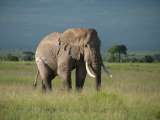
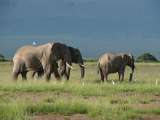

Elephant bull; two elephant bulls eyeing an elephant cow; loving couple
In the second picture above the bull in front clearly shows the musth gland secretion streaming down his cheeks and indicating that he is in musth.
We then met three secretary birds walking through the grass and took a photo of one.
We drove back to the lodge for a good breakfast. After that I did some technical work with one of the elephant research assistants. We drove over to the elephant research camp to greet the two people who are maintaining the camp, back to the lodge for lunch, then headed back to Nairobi.
Far outside Amboseli National Park we met a group of about 10 Maasai giraffes. We had not seen any inside the nature reserve.
The roads out of the nature reserve were unusually good, so it took us less than an hour back to Emali, then about 1.5 hours to Nairobi, and almost another hour in the city traffic, which seems to get ever worse.
We ended up in the Aero Club, took showers (really necessary after the sweaty and dusty drive), and had dinner. After that I connected my computer and wrote these lines.
We received warning that the road from Mai Mahiu to Narok, which we intended to use towards Masai Mara in a week, was totally blocked after flooding and that even the higher road to Nakuru, which we intended to take now, is currently very difficult to drive. This turned out to be true for the first part. The four-lane freeway had quite a few potholes, often big and deep, so driving required extra attention. It was possible to avoid the potholes at 80 km/h, as long as there was no other traffic nearby, but in traffic the potholes were a real problem, for example, while overtaking a truck and therefore being unable to change lanes to avoid clusters of potholes.
Around the Mai Mahiu/Narok turnoff, which we did not take this time, the road changes to two lanes. For a few kilometers we still found potholes, but the rest of the road to Nakuru was excellent. We arrived in Nakuru half an hour earlier than we had foreseen.
After a very good lunch in the Nuru Palace Hotel we met with friends, spent the rest of the afternoon and evening with them, and returned to our hotel at around 22:00.
After breakfast we drove off north towards Baringo. Apart from many speedbumps the road was good. Only when we came closer to Baringo it turned bad again with many potholes and some water damage.
We aimed for the Mogotio petrol station, so we would arrive in Baringo with a nearly full tank for the long drive to Samburu two days later. However, Mogotio had no petrol.
At the station three people told us that there was another petrol station a few kilometers back. The estimates of three different people, one of them a matatu (public minibus) driver, were 5 km, 8 km, and 12 km. So we drove back and, after 12 km, met the same matatu again. The driver was not there, so we asked the conductor. His answer, "It was here, but now it is not around."
We decided that we had enough other options to obtain petrol, so we did not have to drive back all the way to Nakuru, and turned around again towards Baringo. But I registered my mistake was in not filling the tank in Nakuru. My excuse was that Mogotio always had had fuel before.
A phone call from someone in Baringo gave us another hint. Our friends just wanted to learn about our progress, and I told them about my fuel predicament. They told me that there is another well-hidden petrol station along our way, a few meters into a turnoff, so not immediately visible from the main road. We went there and indeed found the Emining Filling Station. And they had petrol, so we could fill our tank.
While continuing towards Marigat and Baringo, we found this fellow in the middle of the road and accelerated his crossing a bit, fearing that the next car might kill him.
Driving through Marigat, we found that not only had the petrol station there reopened, but there were also two other, entirely new petrol stations close by. We topped up our tank with another 2 l and continued to the Lake Baringo Country Club.
The club garden has always been a bird paradise. Around the lake over 500 bird species have been observed.
Due to the unusually intense rains this year the lake has risen to a level not seen since the 1960s. Roberts Farm was mostly flooded, and the club was lucky enough to see the water rise just to the footpath along the accommodations.
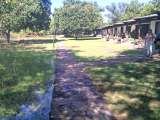
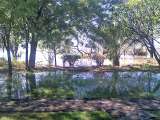
Most of the lodge garden is flooded.
We decided to spend this day in Baringo doing nothing, except perhaps looking at the birds and the lake. Of course we ended up doing a few things anyway, like sorting photos and writing this travel report.
We just had lunch. Here is a photo.
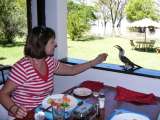
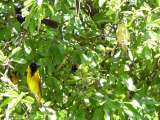
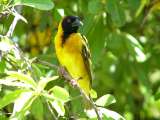
Lunch in the Lake Baringo Club with a hornbill and weaver birds
I am not sure whether I would feel good sitting at that table. Something behind me in the water would certainly distract me.
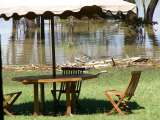
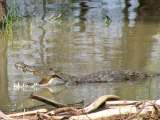
Table on the mostly flooded lawn, complete with crocodile
Most of the lodge lawn is flooded. Only a small stripe remains dry, but even that feels a bit swampy.
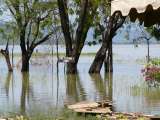
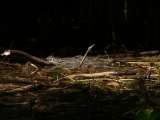
The flooded lodge garden; another well-hidden crocodile
Since we already knew that the road, Baringo – Loruk – Tangulbei – Churo – Mugie – Suguta lol Marmar – Kisima – Lodungokwe – Wamba – Samburu West Gate – Samburu Lodge, had gotten worse and worse over the last couple of years, we woke up at 5:00 and drove out of the lodge compound at 5:30.
The paved road to Loruk was so bad because of many potholes, that we tended to drive with one wheel off the road for some stretches, and needed about 45 min to Loruk. During that time we watched the first signs of dusk in the East.
We turned right at Loruk and should not see any paved road for the rest of the day. While we were gradually climbing out of the Rift Valley, the sun rose in front of us, so we donned sunglasses, pulled down the sun shields, and enjoyed the early morning, whenever the road allowed us to spare any attention.
We drove through the towns and this time did not stop for breakfast in Suguta Marmar. Instead, while driving, we ate the content of one of the lunch boxes we had gotten from the lodge.
I later took a photo of three women carrying firewood. Of course they noticed and came to our car, demanding money. We never give money, but we gave them our second lunch box. I reckoned they could do with some food, judging from the hard work they were doing.
The stretch from Mugie to Kisima on the Rumututi-Maralal road was particularly bad. Even though we never had any trouble getting through, the first part of our drive, up to Kisima, took us 5:30 h for these 140 km, yielding an average speed of roughly 25 km/h without any longer break.
We continued through Lodungokwe, past Wamba, then left the road to Archer's Post and turned south.
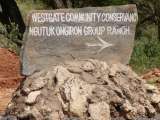
Turn-off to Ngutuk Engiron School and the Samburu West Gate
We drove south towards the West Gate of the Samburu Reserve and already saw many wild animals.
We entered the Samburu Reserve through the West Gate, paid the entrance fee, and continued on to Samburu Lodge. Just after passing the gate we ran into three magnificent elephant bulls. Because of the heavy poaching in the nature reserve, they now tend to stay as far west as possible, away from the area near Isiolo, from where the poachers usually come. As we later learned, approximately 25% of all Samburu elephants have been killed since our last visit a year ago.
We drove on and soon met a family group of elephants, wandering along the river bank. After watching them for a while, we finally moved to the lodge.
The total distance was 286 km and took 11:40 h. Since you have to have some spare time for a breakfast or lunch break, flat tires, and other unexpected events, 12 h seems like an optimistic estimate for this route, and driving out of Baringo between 5:00 and 5:30 is mandatory. The alternative would be to spend one night in Maralal, either in the desolate Yare Camel Club or in the expensive lodge.
After unloading our luggage from the car, we found everything covered with a layer of dust, including ourselves. I later found that the dust had seeped in through the zipper of my travelling bag and drawn a brown line on the clothes that happened to lie at the top.
We took a shower and changed clothes, which felt really good after the long, tedious drive. Then we went for dinner and greeted everybody we knew, particularly the giraffe researcher, whom we had spent time with last year. We also arranged for the car to be cleaned, particularly also the inside.
The night was wonderfully quiet, so we slept better than in any night before, to the sounds of the wind in the trees, the purling of the river, and the continuous sound mixture of the night-active insects and other animals.
We spent time with the researchers here and did game drives, mostly in the mornings and evenings. The lodge compound itself is also a good base for some photographs, because you can see quite interesting animals, big and small, in or near the lodge garden.
A peculiar coincidence was that we met a couple in the lodge, who had rented the our car's "twin brother". We chatted with them briefly. The next morning we drove to the lion project (27 km, 1:30 h) to visit the researcher, whom we have known for many years. To our big surprise, the other car was also there.

The two brother cars with Jeneria, the lion scout
It turned out that the man had worked with the Save the Elephants organisation a few years ago and had stopped in Kenya on his flight back from Madagascar to visit his former places of work. Of course he knew the lion research project as well and also drove over to visit the people there.
Some more photos from later game drives:
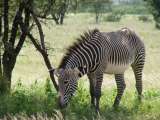
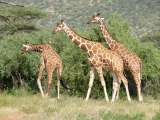
Grevy zebra; reticulated giraffes
Unfortunately, poaching all over Kenya has increased tremendously in the last few years, possibly related to something one could almost call an invasion of Chinese construction crews, who build roads and possibly soon whole tourist resorts in exchange for the right to extract raw materials. In several countries local politicians also line their pockets with huge Chinese bribes, because otherwise the damage done by the Chinese would make them think twice before allowing them in without stricter supervision.
This elephant was shot and wounded a few days ago on the south side of the river, in the Buffalo Springs Reserve, but he made it across the river, where the poachers could not immediately follow. Here he collapsed and died.
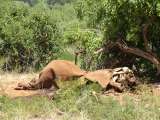
Elephant that escaped his killers, but did not survive for long
Some animals, like monkeys and some insects, have little respect for the dining room.
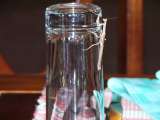
Praying mantis on the dinner table
One evening we set out for a late game drive and found four lions directly at the entrance of our lodge. We followed them at some distance, until they rested in the grass. Two were adult females, the other two were still too young to hunt.
At dusk one of the lionesses spotted two waterbucks that were trotting along a hillside towards the river. She rose and walked briskly in stalking posture through the grass to cut of their presumable path, while the other lioness stayed in place, apparently in the hope that her sister (a guess, but likely) would drive the animals back in her direction.
We followed the first lioness as far as we could, then positioned ourselves such that we would see the hunt, if our guess was right.
We had guessed right. The next thing we saw was the lioness chasing the two waterbucks back along the hillside. Some gazelles, that were in her way, raced away in our direction and only stopped short of our car, not knowing what to do. They then raced past us on both sides, while the lioness was still chasing the waterbucks.
The potential prey took a different direction and could not be caught be the other, waiting lioness. So this hunt was unsuccessful, as are seven out of eight attempts. We can only guess that the waterbucks had already seen or sensed the lions, hence their original escape, and then avoided moving in that direction.
The two youngsters had stayed behind, and now came walking towards their mother or mothers. We watched the pride slowly disappear towards the west, enjoying the feel of the evening, then turned back to the nearby lodge. We arrived just before it would have been too dark to drive without headlights.
We often met elephants, because many of them had crossed the river to our side to escape the poaching on the other side, closer to Isiolo. Since the only bridge over the river in this area was destroyed again by a flood, the poachers tend to stay on the other side, where there are fewer tourists.
On our last morning game drive we again met elephants, among them a group of bulls at the river bank.
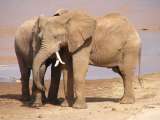
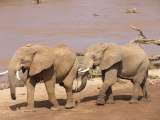
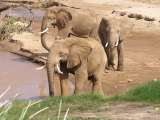
Elephant bulls at the bank of Samburu river
One of the bulls went into the river, apparently to cross over to the other side.
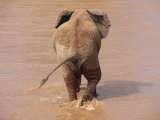
Elephant bull crossing the river
Suddenly we heard a gun shot on the other side. The elephant bull hesitated, listened, and slowly turned around. Then we heard a second shot. At this moment the bull started running as fast as he could. All elephants, the three bulls and a nearby family group, ran away from the river and hid in thick bushes.
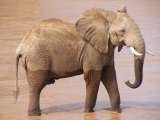
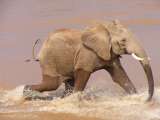
Bull flees after hearing gun shots
This episode made us too sad to continue our game drive, so we turned back towards the lodge. On our way back we took a few more photos.
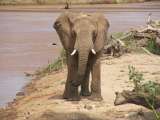
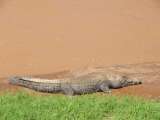
River views: young elephant bull; large crocodile
On our last evening we met a leopard. I took a series of photos and could not decide which one I like most. So here are all of them.
Our time at Samburu has come to an end. We left after an early breakfast and drove slowly towards Archer's Post. We stopped several times to watch elephants that were feeding next to our route. The Samburu elephants are now as tolerant of tourist cars as those in Amboseli and Masai Mara, which makes the close encounters very pleasant. One elephant cow slowly walked towards our car while feeding and stopped only when she was a mere 5 m away.
Feeding is one of the reliable signs of a relaxed mood. As long as an animal is feeding and shows no other signs of irritation, you know that you are not too close, particularly if the animal approached you, while you are standing still.
After passing Archer's Gate and a few km later rolling onto the new paved road in Archer's Post, we drove at high speed, i.e. approximately 70 km/h, towards Isiolo, then on to Nanyuki. On this Sunday many people, often whole families, were walking to and from church in their finest outfits. While driving slowly through the towns, we enjoyed the peaceful atmosphere.
In Nanyuki we withdrew another batch of Kenya Shillings from the Barclays ATM. We had received a recommendation for the next ATM in Naro Moru, but the thought occurred to us that it may be better to have a second ATM still ahead of us, rather than behind us, in case the one we use fails.
Our next stop along this route is always Barney's Restaurant on Nanyuki Civil airfield. We had an all too good lunch and also called Treetops Lodge to inquire about available rooms and prices, particularly because we had heard that there may be ongoing renovations of the lodge.
It turned out that the lodge was nearly empty, except for a group of young Chinese tourists and a family of Indian origin. The prices have been hiked up again. Non-residents now pay US$440 for a double room plus $50 per person for the entrance into Aberdare National Park, which is run by KWS, plus an optional $70 per person for a two-hour game drive before sunset in an open vehicle. We skipped the latter, particularly because it is difficult to see and photograph animals from a forest track. The price for residents, by the way, was KSh12,700 for a double room.
It also turned out that the lodge has been expanded yet again. During that expansion my favorite lookout platform has been transformed into more rooms. Its replacement is now at the top, much higher up and farther away from the animals.
We had mainly decided to come here beause Mausi had never been to Treetops. I think Treetops is the least attractive of the three or four mountain forest night lodges (depending on whether you include the Safari Lodge on Mt. Kenya). I particularly dislike the many staggered fences around the viewing area, a salt lick place and drinking pond. To me this resembles a zoo far too much and has very little to do with primeval nature, apart from the fact that we saw only very few animal species that night, mainly buffalos, a few warthogs and bushbucks. We cannot recommend Treetops, but we still tried to make the best of it and enjoyed it as much as we could. At least the beds were good.
Treetops now also, like The Ark, offers breakfast in the lodge, rather than in the base hotel, like they used to. We had breakfast, then jumped into the bus that took us back to Outspan Hotel.
We tried at first to test the route that Google Maps proposed, but it took us high up the hills on unpaved roads. Then it began to rain and the roads became so slippery that the risk of sliding off the road and getting stuck or worse became unbearable. So we turned back and took the best-known route via Karatina. Google Maps is not yet fully reliable in Kenya.
On our way back we had another insight into driving in Kenya. Some people were working on the road, and the left lane was blocked. There was a man steering the traffic by means of a green and a red flag. Just before we arrived, he waved the red flag, so we dutifully stopped before the barrier and waited, like a good German driver, until the opposing traffic went through and the man would presumably raise his green flag.
After the oncoming traffic had gone through, I stared at the man and waited for him to raise his green flag, but he did not do it instantly. When he raised the green flag a second later, I began to pull over into the right track, when a medium-sized truck honked his horn. The truck had already begun to overtake me and rolled past my car before I could get going.
Thinking about the incident later, it became clear to me that the other drivers in Kenya could not care less about red or green flags. They simply started moving as early as they could, after the last oncoming car had passed. They must have thought that I had fallen asleep.
The next remarkable incident happened after we had driven along the astonishing 10-to-12-lane freeway from Thika to Nairobi that had been constructed over the last two years. In fact, the freeway itself had 6, in some places 8, lanes, but there were two extra lanes to the left and two to the right of the freeway, to provide local traffic in both directions on either side of the freeway. Without these the local traffic would be difficult to manage. On the four-lane Nairobi-Nakuru freeway you regularly have traffic sneaking through in the wrong direction, because it would otherwise be too awkward for these drivers to cover a short distance legally.
After we had driven on the freeway for a while, it felt like a German autobahn, and I drove fast, when I suddenly spotted a speed bump right across all lanes of the freeway. I barely managed to brake early enough to avoid damage or a nasty jump. In Kenya you can take nothing for granted.
With the help of Google Maps navigation we managed to find a good, short way through the center of Nairobi, but we had to cross right through the city center, through Moi Avenue. This went relatively well, and we avoided the usually overcrowded Uhuru (freedom) highway, the spine of Nairobi's cramped street system, though we had to cross it.
After we arrived in the Aero Club, we went into its bar to have a drink, when the people there told us about a hefty explosion that had just taken place in one of the buildings on Moi Avenue. We had driven through it about 27 minutes before the explosion. First reports said that the police did not think that it was a bomb attack, but I have not read any later news yet.
The Kenyans in the cities have lived with fear of terror attacks by the Somali As Shabaab group for quite a while already, but there had not been any serious attacks so far, to my knowledge.
In any case, the risk of a terrorist attack for the tourist, who does not stay in the cities for long, is negligible, compared to other potentially deadly risks, particular that of a traffic accident.
We had arrived in Nairobi with enough time to drive over to Rasul's workshop to have the car checked. This turned out to have been quite necessary, because one of our rear left spring blades had broken. The spring was replaced and the steering adjusted, which had pulled slightly to the right.
We spent the night in the Aero Club of East Africa again. In the evening I had a fever, following a day of poor digestion, apparently one of these unfathomable African fevers that come and go very quickly. I thought it would be better to stay in the club for another day and booked the room for one more night to have more time to recover, but the next morning I felt well enough to cancel this booking and leave.
We slept longer than we would have, if we had planned last night to leave for Masai Mara today. We ended up driving out at 9:00 after breakfast.
Rather than driving through the totally clogged Nairobi, we drove away from the city towards Langata and Karen and drove a wide arc around Nairobi, joining the Nairobi-Nakuru freeway in the far northwestern corner.
We turned left into the road to Mai Mahiu, then left again in Mai Mahiu towards Narok. In Narok our favorite restaurant at the Kenol petrol station was being renovated and was closed, so we drove on to the last station and visited the restaurant there for a little lunch. Then we continued towards Masai Mara.
The road had been good at first, then excellent from Mai Mahiu through Narok until the last 85 km, which were rather bad and forced us to drive at less than 20 km/h for much of the way. That last bit of the way took more time than the much longer way from Nairobi to the end of the paved road. But we made it after a total time of 8 h, including our half-hour lunch break.
After entering the Masai Mara nature reserve and turning right towards Fig Tree Camp, we were greeted by a family group of elephants in the high grass of the savannah plains. The elephants were calm and not irritated by our car, which is a good sign.
We checked into the lodge, got a good rate as well-known repeat customers, and moved into our very nice tent, complete with a live hippo right below in the Talek River.
I jumped into the car again to spend the last hour of daylight with the animals outside and instantly came across another group of elephants not far from the lodge. Then I watched a sleeping lioness for a while and two hyaenas, one of them radio-collared for research purposes.
A funny incident happened when one of the hyaenas inadvertently almost stumbled over the sleeping lioness, jumped back and ran away for a few paces. Then he walked around the lioness at a more or less safe distance of some 10 m and then closed in slowly, apparently to get another glimpse, until he finally walked away. The lioness apparently slept through all of it.
After a very good dinner I wrote this and went to bed, listening to the hippos in the river.
Some photographic impressions:

Scenery with Topis, Impalas, Grant's gazelles, and Thompson's gazelles
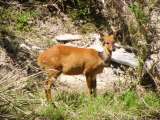
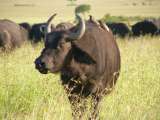
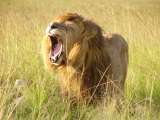
Female bushbuck; buffalo; male lion
We had a wonderful morning game drive and spent most of our morning with two cheetahs. Photo impressions:
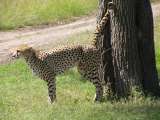
Male cheetah, marking his territory
We wanted to do at least one real early-morning game drive, i.e. one before breakfast, but, lazy as we are, we had put it off until our last full day. Our game drives so far began after a little breakfast, which has the advantage that we do not have to rush back in time for breakfast, but can instead stay out until mid-day.
Mother nature punished us, if you can call it that, by not showing us any big predators this morning. Even the hyaenas were absent, which are normally still walking about in the early morning. We did see Topis and gazelles though, and two bat-eared foxes, very shy, nocturnal, cute-looking predators, which you can only see in the early morning, when they are still up and going home. They were walking away from us, then into the high grass, so no photo this time. But perhaps we are allowed to count them as big predators.
We had to admit though that our previous days had been unusually rich in interesting species. We had seen big cats every day, and every game drive had been very successful. In many earlier years we had not seen all of the big cats. Of course, there is never any guarantee. We had just been lucky or good animal spotters.
We also congratulated ourselves for hitting exactly the right time of the year for Masai Mara. When we arrived and drove in, we still saw heavy rains coming down in the western (the other) side of the nature reserve, and there were still lots of puddles and mud holes, but then the weather became totally dry. On the last few days the sky was almost entirely blue and clear of clouds. We got the impression that the rainy season ended exactly when we arrived here.
Reality is usually not so clear-cut, as the rainy season does not consist of all rain every day, and, conversely, the dry season still has some showers and thunderstorms. The statistics do not show any sharp boundaries between the seasons.
The following picture shows a strangler fig in the medium phase of its growth. It is now beginning to rely on its own soil roots in addition to sucking from the victimized host tree, which is now partly strangled.
Most strangler fig trees that surround the lodge and give it its name are in their final phase, in which the original trees are almost entirely covered and surrounded by the strangler fig and has almost or entirely died.
In the afternoon we drove out again and mapped a few tracks. Still no big predators, but we found some bat-eared foxes again that were not as shy as most of them are. They were apparently father, mother, and one child. We spent a good part of the afternoon with them, watching them and taking photographs.
After an early, quick breakfast we drove out of the nature reserve and soon met some old acquaintances on the way—the three brothers. So they are still alive and well. I am talking about three male lions, who used to be the masters of the northeastern Masai Mara and apparently still are.
We also saw elephants.
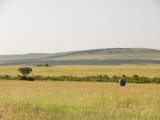
Elephant bull in the grass savannah
The drive back to Nairobi took us close to 9 hours, including a lunch break in Narok. The first 85 km took more than 4 h, because the track is really horrible. Most bigger cars go twice as fast, some even faster, but they have bigger wheels, better suspensions, are longer, and the drivers often don't care whether the car breaks.
Along the way we saw two trucks who carried shoats (Remember? Sheeps and goats) tied down on top of their canvas canopy.
We got back to Nairobi without any big problems.
We almost fell into an interesting new-technology trap, when our phones showed our flight departing one hour later than it really did. The reason was that I had entered the departure and arrival times into the phones' Google calendar as they were shown on the e-tickets. However, those times were given in the respective local times, and Google's calendar cannot even enter a time zone for the end time that is different from the time zone of the begin time. Even if I had thought of this trap, it would have required individual recalculations of the times.
Consequently, as our time zones shifted, the flight times shifted with them, by one hour. Be aware of this trap, if you ever enter flight times like an event with begin and end times into your smartphone's calendar.
But we noticed our mistake in time and shifted all related times.
We set our phones' alarm clocks to 4:15 and 4:20 and still woke up before they rang. Apart from this little problem the day was uneventful. We met the driver along the way, who would return our car, and continued to the airport, where we arrived, as planned, a bit over 2 hours before the planned departure.
The flights were very nice. On both flights one of our seats was at the window, so we could record the flight tracks (shown above).
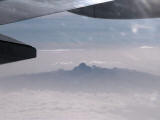
Mt. Kenya reaching through the clouds
The intercontinental flight was unusual in that it formed an easterly arc, passing over Khartoum, Sarajevo, and Graz, north of Munich and Nuremberg, to Amsterdam. Most of these flight lead over or along the western coast of Italy, i.e. much farther to the west (see track map at the top).
We arrived a little tired, but generally in good shape.
If in this text you find any typos, orthographic errors (even small ones), ungrammatical sentences, wrong or illogical information (like wrong names of birds), if you want me to write more details about something in particular, or if you want one of the photos in full resolution (usually 1,600 x 1,200 pixels), please click on the email sign below and write to me. Many thanks!
Copyright © 2012-2023 Hans-Georg Michna.
Private homepage – Hans-Georg Michna
Kenya travel reports: 1999, 2000, 2002, 2003, 2004, 2005, 2006, 2007, 2008, 2009, 2010, 2011, 2012, 2013-Goma, 2013, 2014, 2015, 2016, 2017, 2018, 2019
Kenya Safari Travel Plan, Kenya 1980-2000 photos
hits since 2012-05-11
Free PHP scripts by PHPJunkYard.com